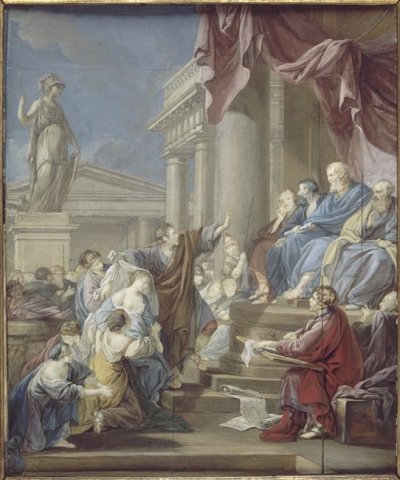Phryne accused of impiety before the Areopagites (Louvre version) - Baudouin
Notice précédente Notice n°60 sur 77 Notice suivante
Description
Booklet from the 1763 Salon:
"By Mr. Baudouin, Agréé.
148. A Priest, catechizing young Girls.
Tableau à gouasse.
149. Several Portraits & other Works in miniature, under the same No."
Phryne is therefore not explicitly announced.
In the extraordinary Mercure de France of November 1763, however, we read:
"Admission to the Académie was already a sufficient title for a very-honorable reputation. M. Beaudouin has just confirmed it with brilliance, & justified the suffrage of the Academicians by the Piece accepted for his reception. The subject of this painting is Phriné, accused of impiety at the Court of the Areopagus, & defended by an Orator who uncovers the head & breast of this beautiful woman in the presence of the Judges. This work is one of the greatest that can be executed in the miniature genre, not only for the extent of its form, but also for its composition and the manner in which it is executed. Everything is well understood, and with a breadth that is uncommon in this type of painting. The effects are true, the characters just right, the groups artistically arranged, the whole well linked, in a word it is a beautiful & large machine in a small space." (p. 201-202).
History of Phryne in Quintilian
"But money, favor, the authority of the speaker, all these persuade too, down to the mute presence of virtue, misfortune or beauty. When Antony, defending M. Aquilius, tore his client's robe, and showed the honorable wounds he had received for the fatherland, he had counted less on his eloquence than on the eyes of the Roman people, who, it is said, could not resist this spectacle, and sent Aquilius away absolved. How did Servius Galba escape the severity of the laws? By the pity he aroused by appearing in the public square surrounded by his young children, and holding in his arms the son of Gallus Sulpitius: this is what several historians attest to, and Cato himself in his plea. As for Phryne, it was not to Hyperides' plea, admirable though she was, that she owed her salvation, but to her beauty, whose triumph she completed by uncovering her bosom. If all this is convincing, then the definition we have quoted is not the right one. That's why those who, while sharing the same sentiment about rhetoric, have defined it as the power to persuade through words, believe they are more accurate". (Quintilian, Institution of Oratory, II, 15, 9)
2. Artist's reception piece.
The story is reported by Pseudo-Plutarch, Lives of the Ten Orators, Hyperides, §20; Moralia, 849e: "As she was about to be condemned, he brought her forward to the middle of the hall and, having torn her garment, exhibited the woman's breast. When the judges saw her beauty, they acquitted her."
See also Athenaeus, Deipnosophists, XIII, 590 d-f.
Other authors claim that it was Phryne who tore her clothes: Alciphron, Lettres d'hétaïres (IV), 4; Sextus Empiricus, Contre les rhéteurs (II), 4.
Technical Data
Notice #000753


